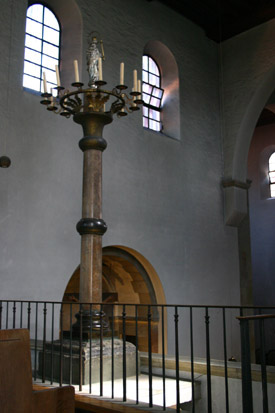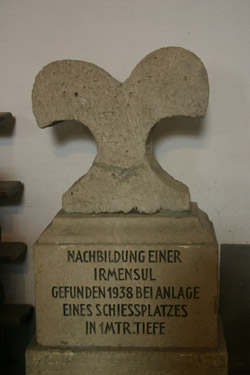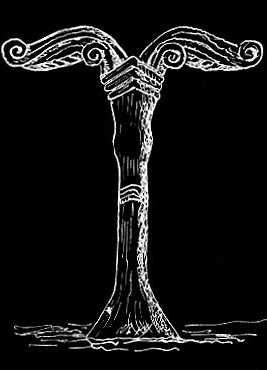 the irminsul
the irminsul 
THE KNOT OF DEATH / THE NINE WORLDS /GERMAN PAGAN LINKS / RUNES / MEANING OF THE RUNES
THE IRMINSUL / THE YGGDRASIL / THE EXTERNSTEINE / THE HISTORY OF HALLOWEEN
The Irminsul was the cultural and religious symbol of the Saxon people, represented by oak or wooden pillars. Beside the Thor's Hammer or the Valknut, the Irminsul has become one of the most important symbols among the northern followers. The symbol of life has largely replaced the symbol of fight, particularly in continental Europe. Past writers have described it by a variety of names. It has been called irmansuli, irmansul, avarian, yrmensule, Ermensul, along with several others. Today it is generally recognized as "Irminsul."
In 772 CE, a pillar located at the Externsteine was destroyed during Charlemagne's wars against the Heathen Saxons. He led his army through a 3 day battle in order to accomplish this feat. The sacred Pillar overhung the big sanctuary of the Externsteine, which was located in the south edge of the Teutoberger forest. The Externsteine and the Irminsul are the heart of the big Thuringian megalithic area. The pillar was the symbol of the Saxons, it's been said destroying it would symbolize the destruction of the saxon peoples soul or in modern times represent as to steal an enemy flag.
Similar columns can be found around England and Germany. Today in England they are called market crosses, butter crosses, perrons, or staples. In Germany they are called Roland Saiile or Irminsaule. The Irminsul is largely tied to the Saxons, although similar Pillars exist in Norway called ondvegssulur (high-seat pillars), these posts were used well into the 1700s CE. They often stood in pairs along side an ondvegi, a high seat which directly translates to "spirit-way." Stave Churches were built with similar pillars called Veraldarsular, "world pillars." Carvings with faces on the tops and heathenish iconography carved on the sides were seen on them occasionally.
Although historically referenced to saxons, these pillars were not unique to the Germanic people. The Greeks pounded wooden poles called hermae into a spot dedicated as a holy place, in order to tame the energy of the world-serpent. The Romans had "Jupiter Columns" and there was mention of the Ancient Indian having similar poles in both Rigveda the the Mahabharata. The Celts also had poles similar to the Irminsul, known as a craeb (branch) or in Gaulish a cantena (pillar). They were placed in the most prominent part of the ritual area.
So what does the Irminsul mean in Germanic Tradition?
There are two points of view: both believing it as being the world column, one group associates it to a particular deity and the other doesn't. As for the first point of view, there are many theories relating to several deities. It was the central pillar that connected all the realms of the gods and spirits to the world of men. The problem with them are, none are entirely provable. First we have those who believe the Irminsul should be associated with Ziu or Donar, then those who believe it should be associated with Heimo or Wuotan. The most cited is it's resemblance to the TYR rune, that the Irminsul is associated with a sacrificial god. Depending on location and tribal preference it could be associated with a variety of gods.
What actual facts do we have:
We know that during the Bronze age the Irminsul was found on carvings usually with some sort of sacrifice. Very often a god was carved directly into the column. It is obviously a column often conceptualized as a tree. The Scandinavian equivalent to the Irminsul is the the Lareap, also known as the world tree or Yggdrasil. Both symbols represent the cosmic pillar that supports the heavens and connect the worlds. It is safe to assume that both of these columns were erected for rituals to send and receive energy via sacrifice.
Etymology:
Irmin, a Germanic god inferred from the name Irminsul is presumed to have been the national god of the Saxons. Although it has been suggested that Irmin was more likely an aspect of some other deity, most likely Odin which is a Neo pagan invention. Irmin may have also been an epithet of the god Ziu (Tyr) in early Germanic times, later transferred to Odin. Odin replaced Tyr as the chief Germanic deity at the onset of the Barbarian Invasions. This view was favored by the early 20th century Nordic writers, but not considered likely in modern times.
It is often said that the Irminsul is the equivalent of Yggdrasil among the Saxon tribes of Germany, but the original sources that attest to it are not clear whether it was a "world pillar" or the pedestal for a cult image. It is also unknown whether the Irminsul made of wood or stone and whether there is one or several. Modern day sources usually refer to it as a pillar or a column.
Theories:
Germania
In Tacitus' Germania, rumors are mentioned of what is described as "Pillars of Hercules" in land inhabited by the Frisii that had yet to be explored. He adds that the pillars exist because Hercules actually went there or the Romans have agreed to ascribe all marvels anywhere to Hercules. Connections have been proposed between "Pillars of Hercules" and later accounts of the Irminsuls.
Externsteine relief and site
According to one particularly well-known suggestion, an Irminsul was situated at or near the Externsteine. What has been described as a bent tree-like design at the feet of Nicodemus. It dates back to the early ninth to early twelfth century AD, and is believed to represent a fallen Irminsul beneath a triumphant Christianity.
Today it is accepted by historians that there is no historic proof connecting the design in the Externsteine relief to the Irminsul. The Eresburg was only about 45 kilometers from the Externsteine, and to an extent there was definitely an Irminsul "near the Externsteine" but extensive archeological studies of the Externsteine have failed to yield any material evidence for their use as a sacred site between Middle stone age and pre-Christian times. Thermoluminescence dating of firesites suggests that the site was sometimes used as a rock shelter in Saxon times, but apparently not to the extent one would expect from a major place of worship.
Jupiter Columns
Comparisons have been made between the Irminsul and the Jupiter Columns that were built along the Rhine in Germania. Comparisons have been made between the jupiter Columns and the Irminsul, but, Rudolf Simek states that the columns were of Gallo-Roman religious monuments, and the reported location of the Irminsul in Eresburg does not fall within the region of the Jupiter Column archaeological finds.
It is believed by many Heathens that the image of a tree bowling down before the cross carved on the relief (shown below) in 9th century CE, is that of the Irminsul. The carving on the Externsteine rocks in the Teutoberger Wald is thought to have been carved near the site of a monastery built to replace the old Heathen site of worship.
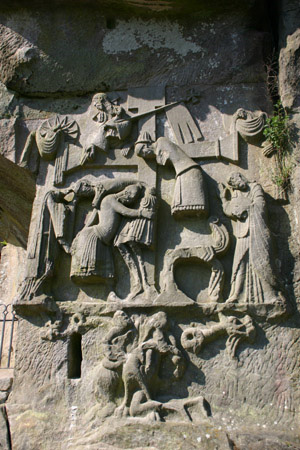
A late 16th century interpretation of an Irminsul bearing the cult image of a god of war and commerce, from Sebastian Münster's Cosmographia
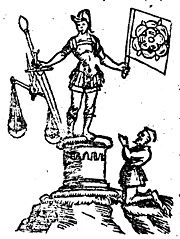

It is said at the time of Christianisation there were many more Irminsuls, some made of wood and may have been lost naturally. One that is made of stone that is still used and can be seen today in a church in Hildesheim, and was made into a candelabrum (candlestick). In Hildesheim, the official story goes that the remains of an Irmin pillar – dating back to Roman times – are present inside the cathedral, “where it has been adapted as a candelabrum”. If entering the cathedral looking for an image similar to the Irminsul of Obermarsberg or the relief of Externsteine, one will find it very disappointing. The only pillar inside the church is a candelabra up a flight of steps. Its interpretation as an Irminsul will only be apparent if one compares it to the depiction of the Irminsul on the commemorative plaque about the felling of the Irminsul in 772 inside the entrance of the church in Obermarsberg.
